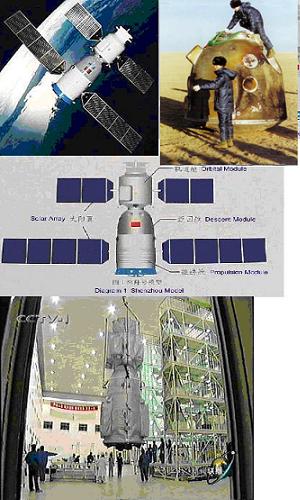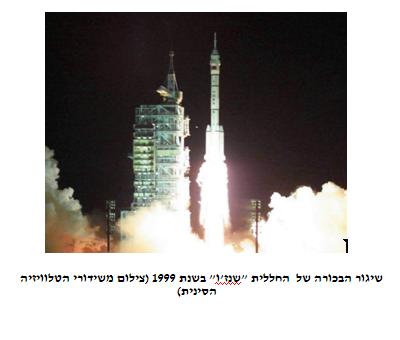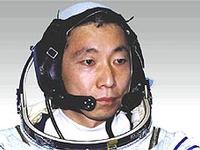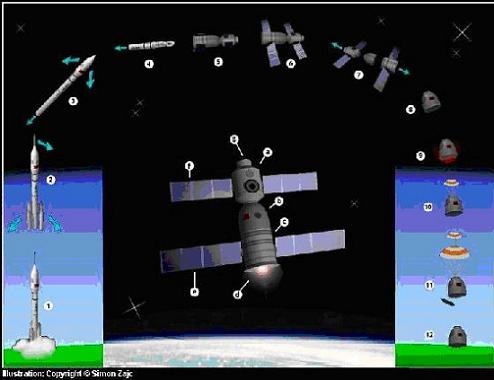Amber dew

In the picture: the spacecraft "Shanzhou" after its landing * Model of the Chinese spacecraft "Shanzhou" - a photograph from an official Chinese publication * The structure of the spacecraft - the orbital compartment above, the command cabin in the middle and the service compartment below * The spacecraft "Shanzhou" in a clean room
Direct link to this page: https://www.hayadan.org.il/inbarchina1.html
China, which began launching satellites using its own launchers back in 1970, already stated years ago that it intends to send humans into space in a spacecraft of its own, place a space station in orbit around the Earth and send representatives to the moon on its behalf.
The Chinese space program is conducted under a veil of secrecy on the one hand, and with attempts at openness on the other, manifested in commercial launches of satellites - including Western ones - on Chinese launchers. In this review we will get to know a little about the Chinese manned spacecraft, and examine its origins. In the future, the Chinese space program for exploring the moon and building a space station will also be examined.
Project 921 of the Chinese Space Agency, known since 1999 as the Chinese spacecraft "Shenzhou" (SHENZHOU - translated as: Heavenly Spirit. The name was given to the spacecraft by the President of China, Zamin) Here, at first glance, is a replica of the old Russian spacecraft "Soyuz"
(SOYUZ) which has been used to launch cosmonauts since 1967, and a replacement has not yet been found. On closer examination, the Russian influence on the Chinese spaceship is evident, but in the design, the Chinese "also drew inspiration" from the structure of the International Space Station, and especially from its American assemblies. The "Shanzhou" launch missile is based on Chinese missiles, which in their structure are very similar to a hybrid between the Russian launchers and the European "Ariane 4" launcher.
The structure of the spaceship
The Chinese spacecraft consists of three main assemblies, according to the Russian model of Soyuz series spacecraft - the command cabin, the service cabin and the orbital cabin.
The command cabin: where the space pilots are located, from where all the various operations required for flying and maneuvering the spacecraft are controlled. It is the only part built for a controlled return to Earth.
The service cabin: in this unit there is a rocket engine, which is activated in the final stage of entering the orbit, as well as at the beginning of the maneuver for reentry into the atmosphere. This assembly is also equipped with oxygen and nitrogen tanks (which make up the atmosphere in the command cabin) and solar cells to generate electricity to charge the spacecraft's batteries.
Orbital cabin: This unit expands the operational space of the crew members, and is equipped with scientific instruments, kitchen facilities and places to store food and other equipment. At the end of the mission, the spacecraft disintegrates into the three components mentioned above, and except for the command cabin, the other two assemblies fall into the atmosphere and burn up in it.
Five launches of the Shenzhou spacecraft have been conducted so far.
The first launch of the spacecraft took place on November 19.11.1999, 196, and the spacecraft was successfully launched into an elliptical orbit with a perigee of 324 km, an apogee of 42.6 km and an inclination of 14 degrees. The spacecraft completed XNUMX laps around the Earth, when a Chinese surveillance ship, which was docked near the coast of Namibia, ordered the spacecraft to activate its deceleration rockets, and upon its return to the atmosphere, the spacecraft traced an arc over Africa, the Arabian Peninsula and Pakistan, passing over Tibet before landing in Mongolia.
After the spacecraft's first flight, the Chinese stated that none of the spacecraft's main systems failed during the flight, so the various backup systems were not tested. In addition, the spacecraft landed at a distance of 12 km from its designated destination.
It is important to note that the Chinese spacecraft, like the Russian "Soyuz" spacecraft, lands on land. When it falls to the ground, it is separated from the heat shield used by pyrotechnic means, and falls. By the way, he discovers four clusters of rocket engines powered by solid fuel, which are operated at a height of one and a half meters above the ground, and soften the impact of the spacecraft on the ground. The used heat shield was located at a distance of five kilometers from the spacecraft, and was collected for testing as to how it functions.
The second launch was conducted on January 9.1.2001, 330, to an orbit with a perigee of 346 km, an apogee of 42.6 km and an inclination of XNUMX degrees.
The "Shanzhou 2" spacecraft contained a sort of "flying zoo": inside the spacecraft were a monkey, a dog and a rabbit, and the main purpose of the mission was to test the life support systems in the spacecraft, in preparation for launching humans inside. In addition to the animals, the spacecraft contained 64 spacecraft - 15 in the return to Earth compartment, 12 in the orbital compartment and 37 in an external unit that was directly exposed to the conditions of space.
Among the experiments - growing crystals under microgravity conditions, visible particles and cosmic radiation, as well as a detector for gamma radiation bursts. On January 16.1.2001, XNUMX, the spacecraft landed in Mongolia. The lack of photographs from the landing site raised the possibility that something had gone wrong during the landing process, but the Chinese did not elaborate on this, only stating that the objectives of the mission were fully achieved.
The third launch was held on March 25.3.2002, 197, and in this experiment, the spacecraft first activated the service compartment engine, in order to raise itself to a higher orbit than the one to which it was launched (the spacecraft was launched to an orbit of 326 x 42.4 km x 332 deg and moved to an orbit of 337 x 1.4.2002 km). The return chamber returned to Earth on April XNUMX, XNUMX, while the orbital unit remained in orbit to continue performing various scientific experiments.

The first launch of the "Shanzhou" spacecraft in 1999 (photo from Chinese TV broadcasts)
The structure of the spacecraft's orbital cell is very reminiscent of the International Space Station's assemblies, but on a smaller scale. This design could allow the Chinese to build a modular space station (such as the Russian "Mir" space station) with relative ease, as well as launch two "Shanzhou" type spacecraft for an extended stay in space of several weeks.
The Shenzo launch on December 4, 2002 was used to prepare for the manned flight that did follow. The fifth launch was, as mentioned, the first manned launch in history that was not carried out by the Soviet Union (Russia) or the USA. The launch took place on 15/10/2003. The Chinese spacecraft "Shanzhou" 5 landed safely in the steppes of Inner Mongolia, at the end of 14 orbits of the earth. In doing so, China became the third country in the world that succeeded in launching a man into space.

The spaceship, carrying the taikonaut (the Chinese name for an astronaut), Lt. Col. Yang Lioyi (pictured), took off into a clear sky at exactly nine in the morning, according to Beijing time. The spacecraft took off as planned from the launch facility in the Gobi desert in northwest China. According to the government announcement, it entered its orbit 10 minutes later.
The Chinese have been training space pilots for several years, and have even presented at international exhibitions and conferences various items that testify to the advanced state of their manned space program. Among the exhibits: space suits, food for astronauts, escape and rescue equipment for astronauts and a special pressure chamber for testing the space suits, and for training the astronauts.
The next article will deal with the Chinese plans to build a space station, a space shuttle of Chinese design, and a manned mission to the moon, planned for the more distant future.
Shenzhou spacecraft mission sequence
https://www.hayadan.org.il/BuildaGate4/general2/data_card.php?Cat=~~~881045894~~~200&SiteName=hayadan

